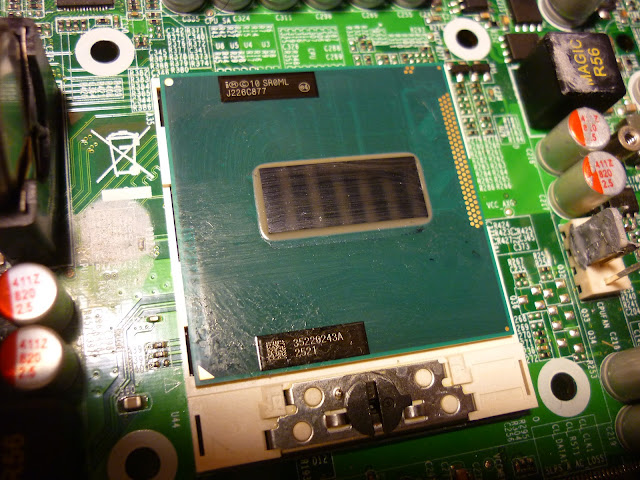<geek mode on>
Went and picked up the CPU, a bargain at $40, installed it this morning in another NG9F-QM77 motherboard, something to do on a rainy Sunday morning. Up and running, all ok, same procedure as the other day so nothing to show, except for the size of the heat spreader, chip is same form factor but the heat spreader is a lot bigger :
The "old" Celeron 1020E was 22nm lithography, Ivy Bridge boasting a TDP of 35W and this i7-3720QM, same 22nm, Ivy Bridge, pushes out a little more at 45W and the heat spreader, or contact area on that mirrored plate in the middle there, looks to be about 50% larger.Simple explanation of lithography is the size of the squares on the "graph paper" of the mask and that the smaller the number, the more densely packed the transistors are on the finished processor. However, the more I talk the more you will realize how little I know.
This Ivy Bridge designation, another of Intel's labyrinth of names, and to muddle it further, Ivy Bridge superceded Sandy Bridge, the latter using the tried and trusted tick-tock on 32nm lithography and the new and wonderful (at the time) Ivy Bridge uses FinFET (3D) Tri-gate transistors and is a die shrink for the previous code name, so it is still a "tick" and not a "tock" and is not a redesign of the architecture.
I read that the tick-tock process still applied and did not end until the 7th generation regardless of FinFET and that's when I lose (more) confidence in the internet, suffice to say Ivy Bridge was fundamentally the same as Sandy Bridge but the transistors were smaller. The NG9F-QM77 motherboards support both Sandy Bridge and Ivy Bridge in the G2 socket, it is logical that the best choice is the youngest, which happen to be more efficient than the older cousin.
The logic that younger processors are better can also be challenged, Intel went through a few generations of marginal, incremental changes, making newer generations better at a few things, but not all the things.
I took a look at what an i7-2720QM Sandy Bridge processor TDP was and the Intel spec sheet still calls out 45W but, the processor runs at 2.20GHz and if I compare passmarks, the Sandy Bridge at 2.20GHz comes in at 4069 (single thread 1376) and the Ivy Bridge at 2.60GHz (for the same TDP) comes in at 5679 (single thread 1870) so thermally, the Ivy Bridge are a lot more efficient. In the first hour or so of operation, I see under load temperatures of about sixty degrees centigrade which, is about ten degrees hotter than the i5-3230M, but not bad at all for a fanless PC.
Excellent stuff, I have learned something today, I had not realised that Ivy Bridge are backwards compatible with the Sandy Bridge (BIOS update may be required) and that they use less power per compute. In addition, Ivy Bridge is the last Intel platform to support Windows XP and the earliest Intel microarchitecture to support Windows 10, 64 bit.
I also learned that the internet talks a lot but does not say much, so I have that in common.
<geek mode off>

No comments:
Post a Comment